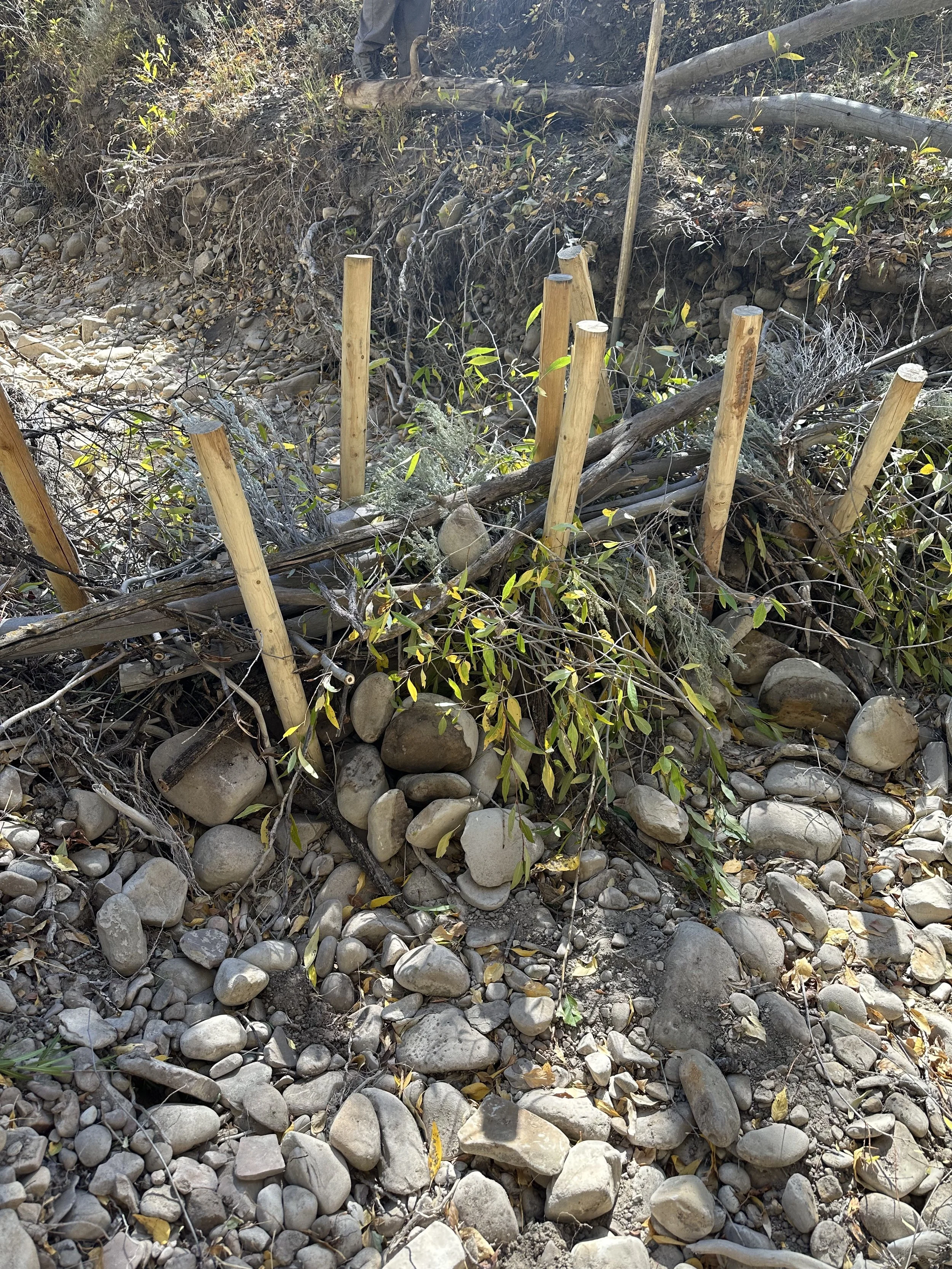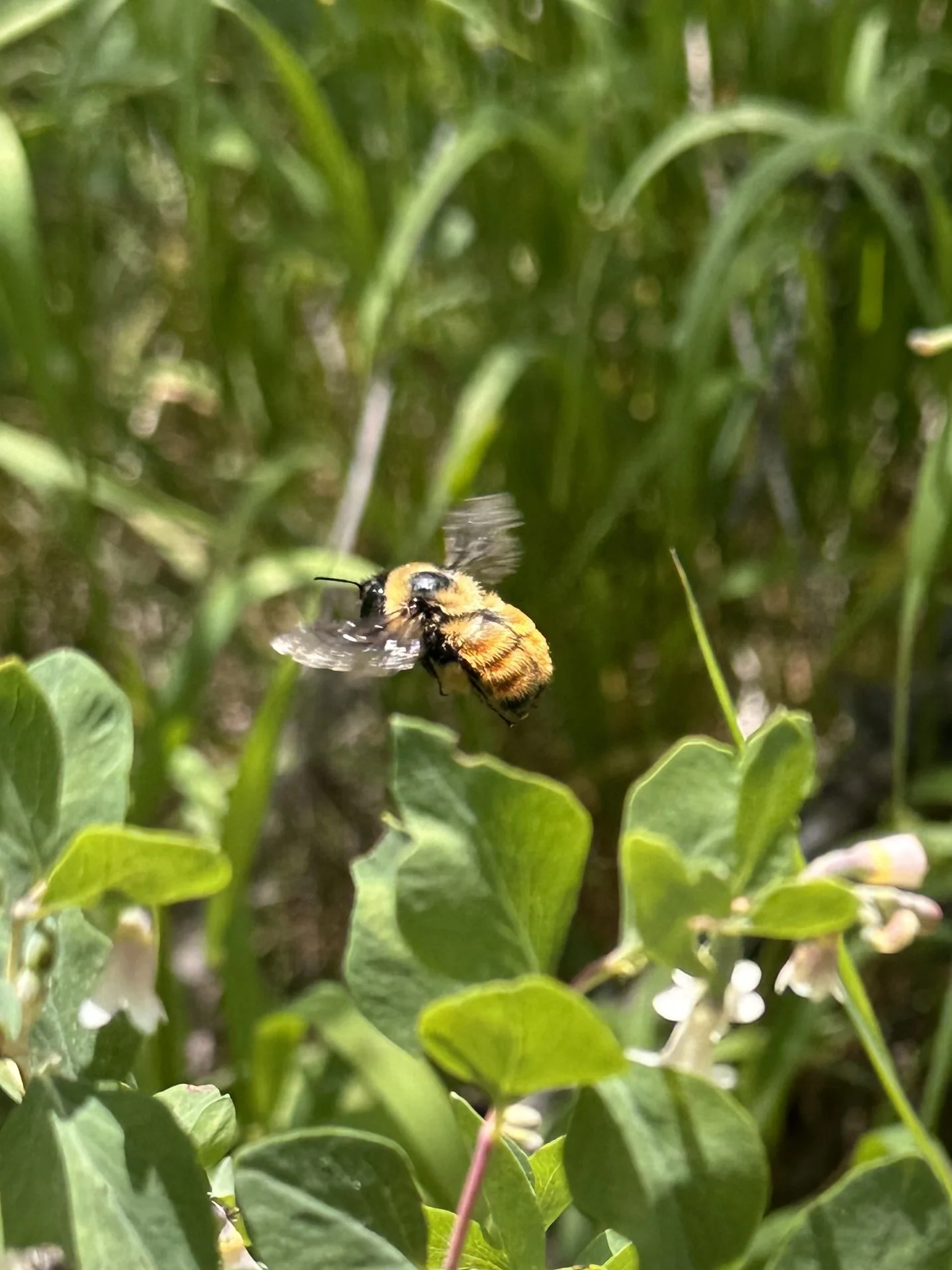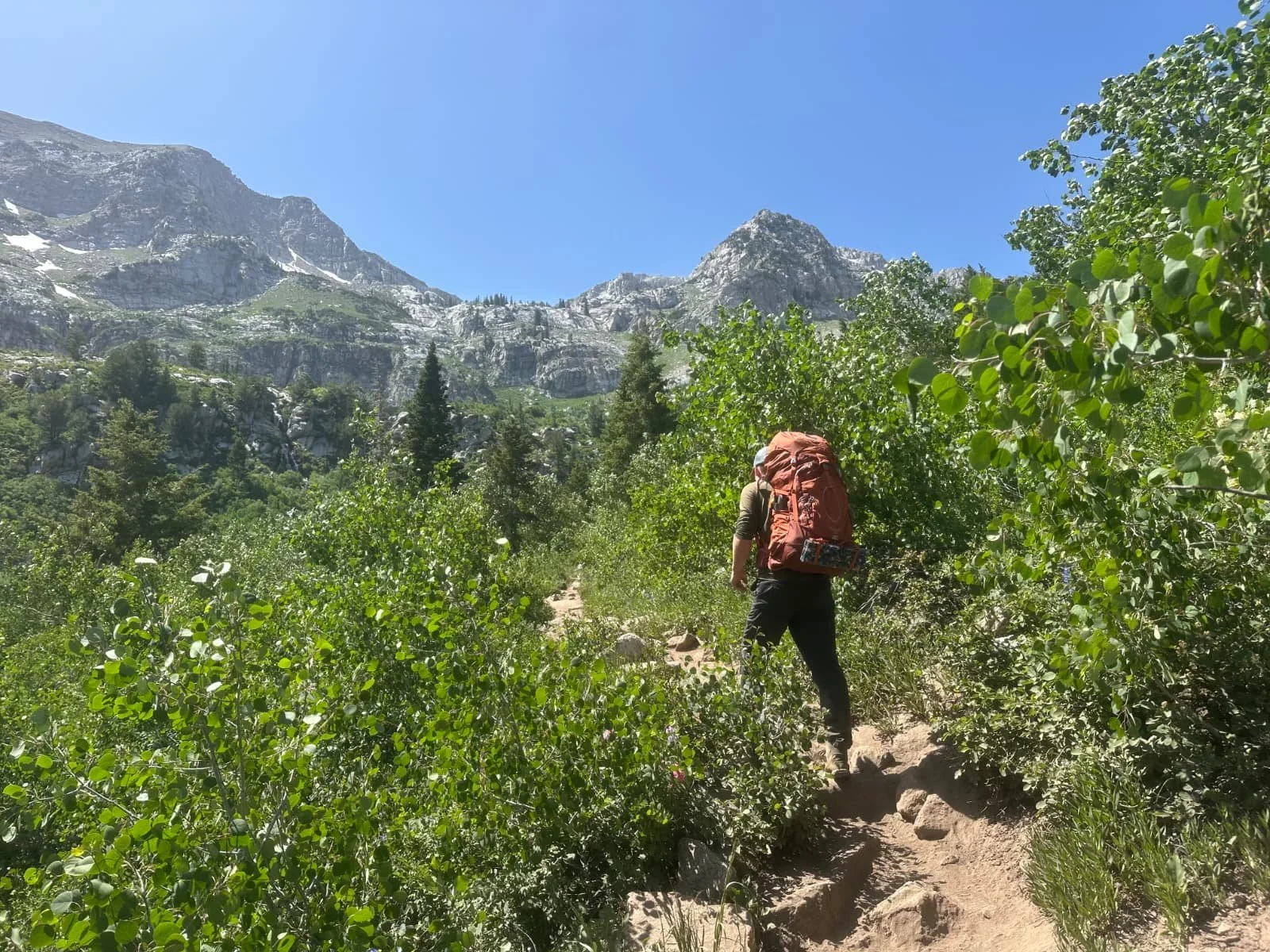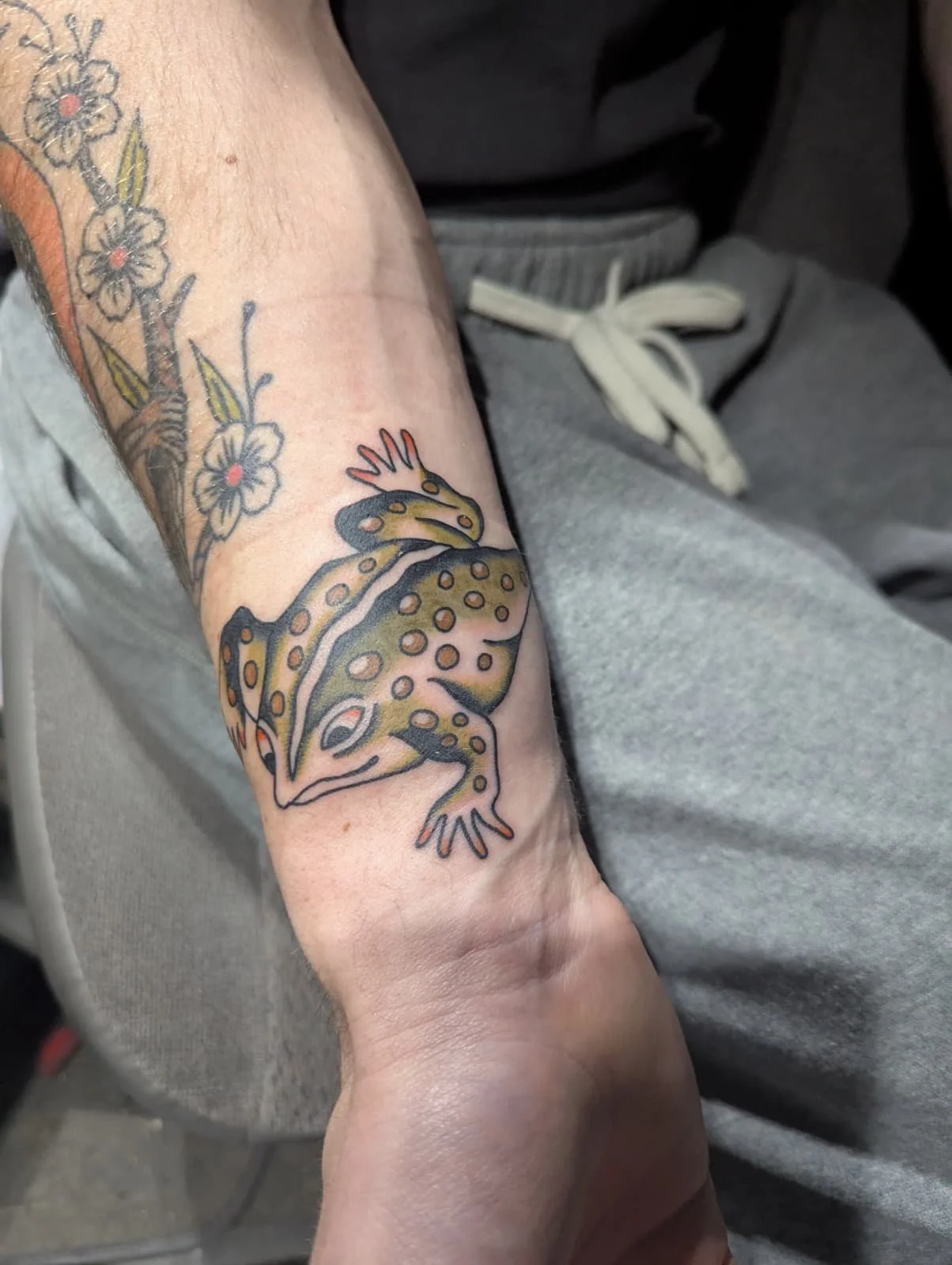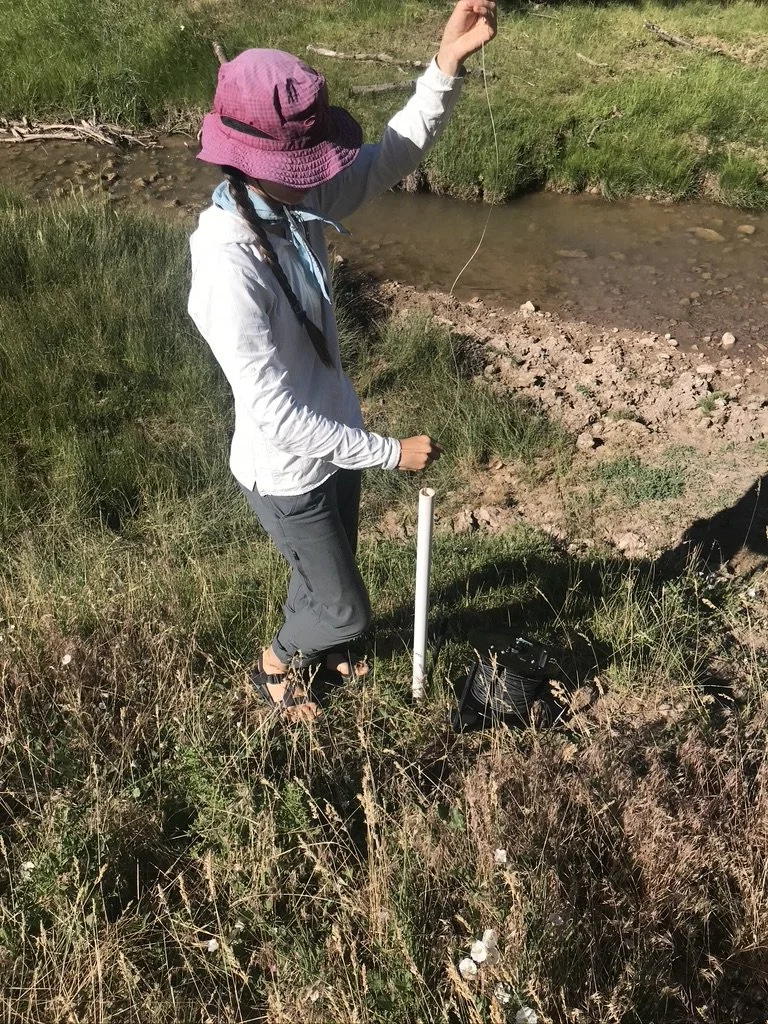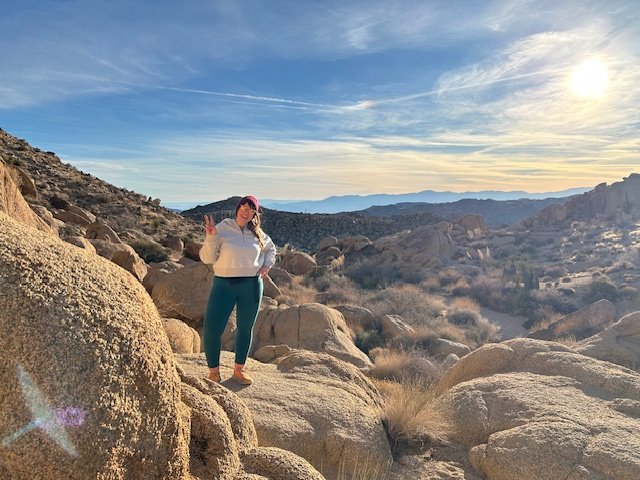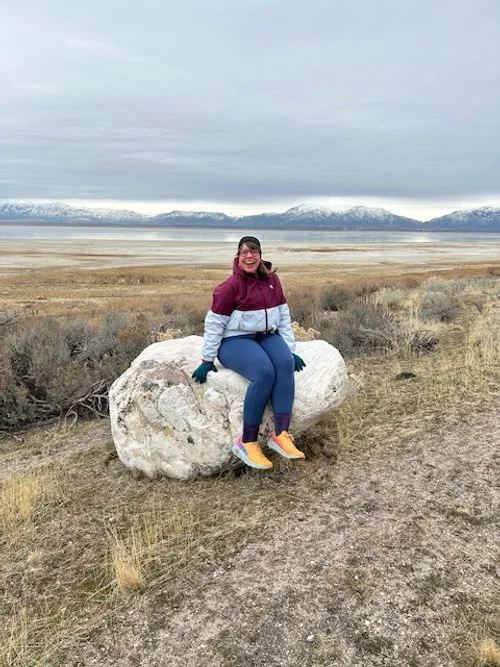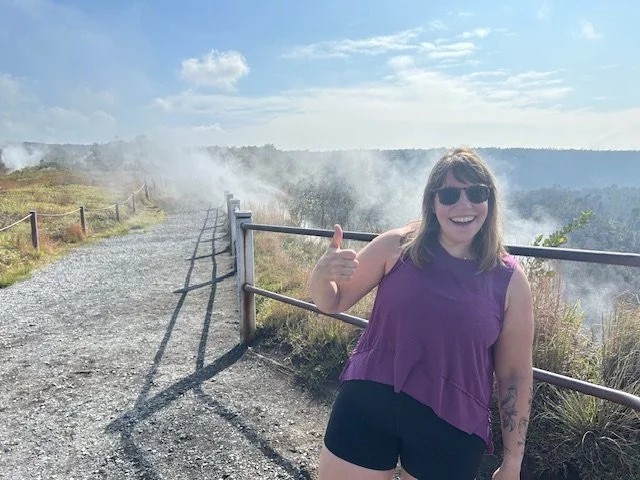2025 Honorees of the Year
Sageland Collaborative’s 2025 Honorees of the Year. From left to right: Lucas Faircloth, Alex Porpora, Parker Lloyd, Aurianna Dun, Hunter Wade, Esther Sumner, Lily Bosworth. Not pictured: Franque Bains, Ryan Oakey.
At our 2025 End of Season Celebration, our team celebrated big wins for wildlife amid a crowd of enthusiastic partners and volunteers. As our field season winds down for the winter, we wanted to extend recognition to the many people who make our conservation work possible. Below, you’ll read about the experiences and stories of dedicated volunteers, partners, and board members dedicated their time and passion to working alongside us in 2025.
Volunteers of the Year
Overall Volunteer of the Year: Auriana Dunn
Get to know one of our superstar volunteers, Auriana, in our interview with her:
I've been involved with Sageland since last summer (2024). I initially started with Wildlife Watch as a part of Austin Green's research lab at the University of Utah, which is how I heard about Sageland. I then got to join a Riverscape Restoration day last October where I got to build beaver dam analogs (BDAs). What I love most about volunteering is the chance to get outside, have potential opportunities to see wildlife, and be a part of real and impactful conservation work. I think my most memorable field experience was seeing itty bitty baby snowy plovers during the Shorebird Survey. So cute!!
In the summer of 2023, I was lucky enough to study abroad in Patagonia, Argentina, where I was able to see and study Southern Right Whales. Seeing those whales in the flesh and learning about how their populations have made a comeback due to conservation work, is what sparked my love for this work. Since then I have wanted to be a part of wildlife conservation and be a part of getting other species' populations to bounce back.
If you're thinking about getting involved but haven't yet, just go for it! I guarantee, even if it's not for you your won't regret it. You'll get to spend a day in nature, meet cool new people, and get your hands dirty!
Utah HerpSearch/Western Toad Volunteer of the Year: Ryan Oakey
Ryan shares more about how he joined our conservation community:
I started volunteering with Sageland Collaborative last spring/summer. Honestly, I was new to Utah and looking to find friends and a community of like-minded people.
The most memorable experience I’ve had in the field was this past summer when my partner and I did a toad survey at a small wetland up American Fork Canyon. It was an area of interest that had not yet been surveyed and didn’t have a trail to it. We turned it into a backpacking trip to a nearby lake. Between bushwhacking, rock scrambling, and somewhat sketchy snow crossings, it was quite an adventure. I have a goal to find a previously unknown breeding population of Western toads, so I expect to be visiting many more un-surveyed areas in the coming summers.
As a child, I regularly caught frogs, snakes, lizards, and really anything I could get my hands on. Now I get to experience that same childhood wonder as an adult, but this time in the name of science and conservation. Plus, it gives me the opportunity to see beautiful areas that I normally wouldn’t visit. I didn’t have many opportunities to volunteer in conservation until I moved to Utah and started volunteering with Sageland. I’ve had such a great time, I’ve started getting involved in conservation more broadly and have even been considering a career change. I may not be able to solve all the world’s problems but I can do my small part by lending my time and skills to protecting all life on our beautiful planet. To commemorate my initiation into conservation, I even got a tattoo of a Western toad.
After having lived in England, perhaps one of the most wildlife depleted areas in the world, I just hope that the American people can learn from our predecessors’ mistakes and protect not only our public lands but also the flora, fauna, water, and soil we rely on for clean air, water, and food. My part in this may be small but I try to encourage as many people as I can to get involved. I’ve seen even a singular experience in conservation change the way people treat the natural world and even how they vote, which is perhaps the most important thing we can do to solve the biodiversity collapse and climate crisis we find ourselves in.
I just wanted to say thank you to everyone at Sageland Collaborative, the Hogle Zoo, and all the volunteers. I’m a better person because of the work I’ve done in conservation, and I’ll always be grateful for the part volunteering in the western toad and river restoration projects have played in getting me involved in conservation.
Riverscape Restoration Volunteer of the Year: Lucas Faircloth
Learn more about Lucas’ experience as an Honorary Beaver in our Riverscape Restoration Project:
How long have you been involved with Sageland Collaborative? How did you initially hear about the organization? I googled it one day. I needed something to do. I guess I've been involved since 2019, back when it was the Wild Utah Project and used to donate to them, but I never had time to volunteer until recently.
What do you love most about volunteering on our community science projects? It gets me out of my apartment. It's nice to be in the woods and in nature.
What is your conservation/wildlife origin story? Is there an experience or memory that sparked your love for this kind of work? I used to be an Americorps volunteer for the Arizona Conservation Corps. I did two seasons, so about a year. I did it because it seemed interesting. It was fun. It was dirty work sometimes but I would rather do that than customer service.
Any memorable experiences you’d like to share from the field? I remember talking to one of the ranchers on whose property we were doing pollinator planting. He said that the area in which he lived (Coalville area) used to look a lot different when he was a kid; big aspen groves and the creek was more active. In general, he said that the area looked a lot dryer and less healthy than it was when he was a boy.
What is your hope for the future of wildlife and land in the West? How do you hope your contributions further this vision? Hard to say. I want to preserve the places that are still wild in the west. I don't think we should pave over everything. I don't want the entire world to be nothing but urban sprawl, traffic, and smog. Hard to do with so many people moving to Utah, and the west. I'm a bit stumped on how we accommodate a growing population and still preserve the wild.
What would you say to folks thinking about getting involved? It's a good way to get outdoors and learn about the environment. You have to invest effort and money to manifest what you want to see in the world. I want to see the wild places stay wild. It's better than stagnating in your apartment and doomscrolling.
Anything else you’d like to share? If you listen to the news, it seems like there are a lot of mental health problems in the world right now. More people are lonely than ever right now. Sometimes you hear about things like the epidemic of loneliness, especially with people younger than me. Especially young men. I think that getting out and serving the community, or serving nature helps ease some of that loneliness and anxiety. I wish that more young people would get out and do more of this stuff instead of sitting in front of the computer, or endlessly scrolling on the phone. I'm not saying that volunteering is a cure all for what's happening right now but I think it helps.
Intermountain West Shorebird Survey Volunteer of the Year: Esther Sumner
Esther shares more about her birding experience below:
I have been involved with Sageland Collaborative since 2022 and I have participated in every Intermountain West Shorebird Survey in the same spot for four years now. It’s been fascinating to watch the land change with the weather, and see how that impacts what birds we see. Our first year participating in this survey, we walked for over a mile to get to the shore. The earth was dry and deeply cracked, and up by the water, there were dozens and dozens and dozens of dirt mounds; microbialites, I believe. The shoreline was covered with masses of phalaropes, and there were a lot of peeps flying back and forth. It took us a long time to count and ID all of the birds. Last spring, in contrast, it rained so hard that we were wearing all of our rain gear, kicking water with every step even though we were on land. It was amazing to see the land holding water on its surface like that; everything was so saturated. That survey, with it raining our entire survey, we only counted 10 species overall.
I have only ever seen three whimbrels in my life, and until this year when I had another fly over me at Antelope Island, my only whimbrels that I had seen were during the Intermountain West Shorebird Survey! One of those whimbrels was on the survey where we were rained on pretty much the entire time, so that was a special sighting. I also learned how quickly you can cement your feet into the mud at the Great Salt Lake. I got pretty stuck in the water trying to get a little closer to a peep to ID it better, and my friend had to walk over and pull me out while I tried to balance my camera and binoculars.
How do you envision your contributions making an impact on shorebird conservation?
The more we educate others - both birders and non-birders that passively enjoy nature, the more we can help others become aware of how their actions have a ripple effect, all the way to these beautiful birds. Just this week, I had someone that isn’t a birder, and that lives outside of Utah, ask me if it was true that the Great Salt Lake was in danger from low water levels, and if that was dangerous overall. I was able to share with him some of what I have learned and personally experienced about brine shrimp and birds at the Great Salt Lake, as well as about toxic dust. I initially learned all of this through my volunteer work.
What would you say to folks thinking about getting involved?
Just do it. I have learned so much, made so many new friends, and had so much fun over the years through volunteer work. Pick something that interests you, even if you know nothing about it, and sign up! There are so many opportunities to volunteer at Sageland, as well as other groups that I’m associated with, that I’m able to to choose if I want to capitalize on a skill of mine (for example, organizing people and schedules for my local Christmas Bird Count capitalizes on a personal skill), or if I want to get out into the field (Shorebird Surveys), or maybe if I want to mingle with others (for example, planting things together).
Through volunteer work, I have made new and dear friends, become acquainted with parts of Utah that I hadn’t accessed before, and I’ve learned a lot - about birds, trees, plants, and other wildlife. Also, don’t be afraid to show up alone. Volunteering is a great way to make new friends.
Utah Pollinator Pursuit Volunteer of the Year: Parker Lloyd
Get to know Parker below:
How long have you been involved with Sageland Collaborative & Utah Pollinator Pursuit?
My first time volunteering with Sageland Collaborative was in the fall of 2023 on a BDA near the Wyoming border. It was a marvelous experience where I met many fantastic people - I was permanently indoctrinated into the Sageland community. Now I toad, I bee, I beaver, and I bird alongside dozens of fabulous ecologists and volunteers every year. My first Utah Pollinator Pursuit observation was even earlier in the summer of 2023, a Brown Belted Bumblebee (Bombus griseocollis). My love for pollinators, however, goes back to childhood. I grew up on a small farm in rural Oregon, and I remember, as a child, chasing bumblebees and other bugs.
What do you love most about volunteering on our community science projects?
Sageland’s dedication to community science and community-based conservation represents a unique and forward-thinking shift in conservation, enabling broadly compelling, accessible storytelling that inspires future ecologists and encourages meaningful work. I love the chance to contribute to meaningful scientific endeavors, but the real win is mingling with passionate enthusiasts across so many disciplines, industries, and agencies. Who better to explain toad predators or migratory shore birds than the incredible nerds in the field? Working with Sageland has connected me to a network of unique experts in any subject you can imagine: got a question about bats or the hydrology of the Jordan River? I know a person.
Any memorable experiences you’d like to share from the field?
Midsummer, while carrying out a Bumblebee Atlas Survey at Strawberry Reservoir with Sierra Hastings and Zachary Earl, we were confronted by a wonderful family fascinated by what we were up to. To the uninitiated, a group of adults sitting on the ground with handfuls of sleeping bumblebees certainly looks odd, and they were understandably curious, particularly the 3-year-old child. Initially, she was horrified, fearful of the very existence of the insects she had been conditioned to fear since first stepping outside. After a brief introduction, however, that fear turned to intense curiosity, and the next fifteen minutes were spent carefully supervising gentle, yet surprisingly grabby, tiny hands. The human element aside, this was a remarkably prolific survey site, where, in our window, we caught close to 40 individual specimens, including a massive Queen Bombus nevadensis and numerous tiny Pyrobombus foraging in the vast fields of Lupine and Penstemon.
Can you link us to your top 3 favorite UPP iNat observations you made this year?
Two of my favorite findings this summer happened on the same day in the Uintas: Colletes sp. (The Cellophane bee) and Epeolus sp. (The Cellophane Cuckoo Bee). These two bees were in the same general area (one on the side of the trail, and the other 200 meters up the mountain), and both are under-documented and poorly understood. Epeolus is a type of Cuckoo bee, a cleptoparasite that invades nests, depositing eggs that displace the natural inhabitants and feed off the hard-earned pollen and other resources gathered by the hosts. Because of this behavior, they do not collect pollen themselves to feed their offspring, and often have few hairs, resulting in fabulous silky patterns and streamlined colorations (including charismatic “emoji” patterns on the thorax). These relationships are frequently precise, down to a particular genus or even species, as with Epeolus, which exclusively parasitizes the nests of Cellophane bees. Despite this seemingly horrific behavior, it is a natural part of the insect world, with its own checks and balances; the presence of a cuckoo bee in an environment generally suggests a robust and healthy host population. Finding the host and the cuckoo bee on the same ridgeline was a remarkable moment.
Another standout specimen is this Bombus insularis, another cleptoparasitic cuckoo bee, found near Mt. Timpanogos. She was, without a doubt, the largest bee I have ever seen, and not only was she tremendous, she was patient enough to allow me to hold her gently. The gargantuan Queen greeted me on the ascent and was still perched on her floral throne, waiting to cheer my return down the mountain; like many bees, she was fond of the Western Coneflowers that persist into the late summer.
What would you say to folks interested in getting involved?
iNaturalist is a fantastic resource, not just for the Sageland community, but for anyone interested in the natural world who wants to make real impacts on natural science and learn more along the way. My observations in Utah have inadvertently aided scientists worldwide in understanding the diversity of oak tree hybridization, the taxonomy of Hedgehog cacti, and the distribution of fossorial Pleistocene snails. More people collecting more data makes real impacts on fields of study you haven’t conceived of, and this is the real beauty of community science.
Anything else you’d like to share?
Fun things are on the horizon! Follow @thesassyteapot and @utahnativeplantsociety on Instagram for more plant- and pollinator-themed antics—special thanks to my dear friends Sierra Hastings and Amanda Barth for their endless patience and infectious enthusiasm, as well as all my botany friends who enable and encourage my nonsensical adventures to remote corners of the desert.
Fence Restoration Program Volunteer of the Year: Hunter Wade
Hunter shares this about his experience volunteering with us:
How long have you been involved with Sageland Collaborative?
I have been involved with Sageland Collaborative for about 2 years now, starting with the Wasatch Wildlife in the winter of 2023/24.
What do you love most about volunteering on our community science projects?
I love being able to interact with other wildlife enthusiasts and share stories of wildlife, and educate each other, because every part of science can and should be collaborative.
Is there an experience or memory that sparked your love for this kind of work?
I have two, the first being visiting SeaWorld as a very young child and "playing" with an orca, where I ran back and forth along the enclosure, and it swam right alongside me, clicking the entire time, and I have dedicated myself to learning about wildlife from that point on. What really got me into "boots on the ground" conservation, though, was in high school when I noticed the canyon my buddies and I would always hang out in was being filled with trash and cans. To beautify the area we loved, we started organizing monthly cleanups and collecting trash bags full of empty cans. This really opened my eyes to the issues wildlands are facing.
Any memorable experiences you’d like to share from the field?
One of my favorites happened just recently, during the inaugural fence restoration day. We were able to actually watch deer come up the fence and cross underneath, right where we had removed the bottom strand of wire just minutes before. Seeing the difference we were making in real-time almost instantly was amazing.
What is your hope for the future of wildlife and land in the West? How do you hope your contributions further this vision?
I really hope to see the pronghorn populations bounce back and the Great Salt Lake rebound and continue being the thriving ecosystem it is. I hope my work in wildlife and ecology, especially through Sageland Collaborative, can realize those dreams.
What would you say to folks thinking about getting involved?
Do it, make a difference now. There is no better time to start than today. Our wildlife could use our help, plus it is always fun to get the boots dirty.
Anything else you’d like to share?
The biggest difference you can make is to care and let others around you know why you do. "Unless someone like you cares a whole awful lot, nothing is going to get better. It's not." -Dr. Seuss.
Partner of the Year
Franque Bains, Sierra Club & Outdoor Afro
If you haven’t had the opportunity to meet Franque yet, read on!
Can you tell us about yourself and your role with the Sierra Club & Outdoor Afro?
I've loved the outdoors since I was a kid, just playing outside, riding bikes and climbing trees. That's led me to this work of protecting our outdoor spaces. That started out as activism in Salt Lake City, and has evolved to my work as the Chapter Director of the Sierra Club and an Outdoor Afro Lead.
What value do you see in collaborative partnerships in conservation?
The work of conservation is community work. Every organization has something unique and different to offer. The Sierra Club for example has a powerful volunteer base that does the heavy lifting of getting citizens engaged in writing LTE's, attending rallies, and providing testimony against bills and actions happening in our state. We don't have the staff expertise to engage in citizen science and hands on conservation efforts in our wild spaces. Partnerships allow us to connect citizens and volunteers to wider variety of efforts that they can engage in. We all want to see our wild spaces protected. When we work together, we get so much more done, and people learn so much more about how to protect the outdoors.
When you work in one space, you may think that is all there is. When we collaborate, our communities get so energized by learning other ways to engage in helping conservation efforts.Can you share any highlights or notable experiences from your time partnering with Sageland Collaborative?
Really every time I have volunteered with Sageland has been an incredible experience because I learn so much and have so much fun doing so.
Board Member of the Year
Lily Bosworth
We are honored to have Lily Bosworth on our board! Her enthusiasm, dedication, and perspectives have allowed us to make strides in Sageland’s mission.
Get to know Lily:
How long have you been on the Sageland Collaborative Board of Directors, and what inspired you to join?
I've been on the Sageland Collaborative Board of Directors for about two years. I was inspired to join because I had seen how Sageland weaves together community and conservation. Each project helps people connect to each other and to our environment through action, and I wanted to support such joyful and impactful work.
You’ve contributed so much to our organization through your involvement - what have you gained from your time on the board?
Since I started serving as a Board Member I've gotten to learn about a range of things, from non-profit policy details to how to build strategies to achieve our mission. Most importantly, Board service has been an opportunity to consistently come together with the rest of the Sageland community to learn from the staff, fellow Board Members, partners, and volunteers.
What is your conservation/wildlife origin story? Is there an experience or memory that sparked your love for this kind of work?
I’ve been involved with community-based conservation since I was born! My mom served on the Ogden Nature Center Board when she was about my age and went on to work there for over 20 years. My legs and science-mind grew up together wandering the Nature Center’s trails and the Ogden trails, wondering at the creatures who found refuge in my home ecosystem's trees, fields, and ponds. Each lesson about the natural world I learned during my early trail days is tied to a lesson about the importance of community protecting ecosystems. For example, feeding injured birds with my dad taught me intergenerational and inter-species caretaking, pulling invasive plants with other volunteers taught me shared responsibility and accountability, and finding frogs with my friends brought us collective joy and celebration.
What is your hope for the future of wildlife and land in the West?
I hope wildlife, lands, and communities in the West can continue to strengthen one another. Many of us are drawn to Sageland's work because of the beauty, wonder, and lessons we've gained from the West's wildlife and lands, and I hope our communities can return as much to our ecosystems as we receive.
What would you say to folks considering getting involved?
Being involved with Sageland recharges me every time I engage with the team and the projects, and I hope you can experience the same thing! Find a project that excites you, trust that Sageland's staff will meet you wherever you are in terms of knowledge about the project and will help you learn along the way, and bring a friend!
Donor of the Year
Alex Porpora
Meet Alex Porpora, who also happens to be a proud board member!
What inspires your support of Sageland Collaborative?
At the risk of sounding cheesy (and like a board member!) I believe in Sageland Collaborative’s mission and the people behind it. It takes a lot of work to make Sageland’s mission become reality and I am continually impressed by the team behind these efforts. I feel like I always learn something new about a project or wild place when I connect with staff. It also takes a lot of heart to ensure that big, multi-organization projects move forward and this team always leads with collaboration.
On a deeper level, I moved to Salt Lake City nearly 20 years ago and, well, I’m still here! I became enchanted with the wild spaces and places in our state. Sageland’s vision of a future where our communities thrive based on interconnected ecosystems, wildlife and people feels important and personal to me. I want to ensure that we don’t lose that indescribable magic that’s found when you’re among thousands of shorebirds (and infinite brine flies!) at the Great Salt Lake, or the wonder that you feel when you notice a new or interesting species in your neighborhood. Sageland’s mission to provide science-based strategies for wildlife and land conservation make this possible for us now and for generations to come.
What is your hope for wildlife, lands, and communities in the West? How do you see your support contributing to this vision?
If you caught me on an off, cynical day, I’d probably say something like “I hope wildlife still exists in Utah in 100 years!” and it’s easy to feel this way sometimes. I mean, you read the news, right?
Which is why it’s so important to look for the places where there has been success so that we can continue building upon positive impacts. My ultimate hope would be that Sageland Collaborative would be so incredibly successful that we shift policy and thinking about wildlife and lands in such a way that they no longer need to exist. Ideally, every nonprofit wants to put themselves out of business because they have solved the problem, but nothing is ever truly done.
In lieu of that vision, I know that my contributions to Sageland Collaborative help create meaningful, on the ground action that support wildlife, create healthier lands and bring people together. My short term hope is that we can bring people together around this shared goal to continue to make Utah a place we all want to call home.
What would you say to others who are looking to make an impact?
There is perhaps a misconception that in order to make a big impact in supporting an organization you care about that you need to have a ton of extra time or lots of extra cash to donate. These are limited resources for most people! If an organization’s mission resonates with you, like Sageland’s does for me, know that any gift makes an impact.
As a board member, I often talk about the importance of people sharing their time, talent and treasure with Sageland Collaborative and how all of these contribute to the success of Sageland and the landscapes and people they work with. I encourage you to think about how you can use your own time, talent and treasures in the same way! Maybe you have the spare time, adventurous spirit and hiking aptitude to help with the Boreal Toad Project. Maybe you wish you could get out into the field but you can’t so you set up a $15 monthly donation instead. Or, you’re so inspired by Sageland’s work you share it with your network of friends. No matter how small of an action, it has an impact. The most important thing is supporting something you believe in.
Thank you to all of our outstanding volunteers. We appreciate that you continue to share your invaluable time in service of the wildlife and lands that we all love.
To our partners who contribute countless hours, unmatched passion, and expertise that we so rely on, we offer our deep gratitude. And to our donors, your contributions allow all this work to move forward. Gifts of any size allow us to continue working to provide these services, to bring on more volunteers, and to protect wildlife and lands.
Thank you all so much for joining us in these efforts! We look forward to getting back out in the field with you next year to conserve wildlife and lands.
Article by Frances Ngo
Photos shared by Sierra Hastings, Lily Bosworth, Auriana Dunn, Parker Lloyd, Esther Sumner, Ryan Oakey, Hunter Wade, Franque Bains, & Alex Porpora.



